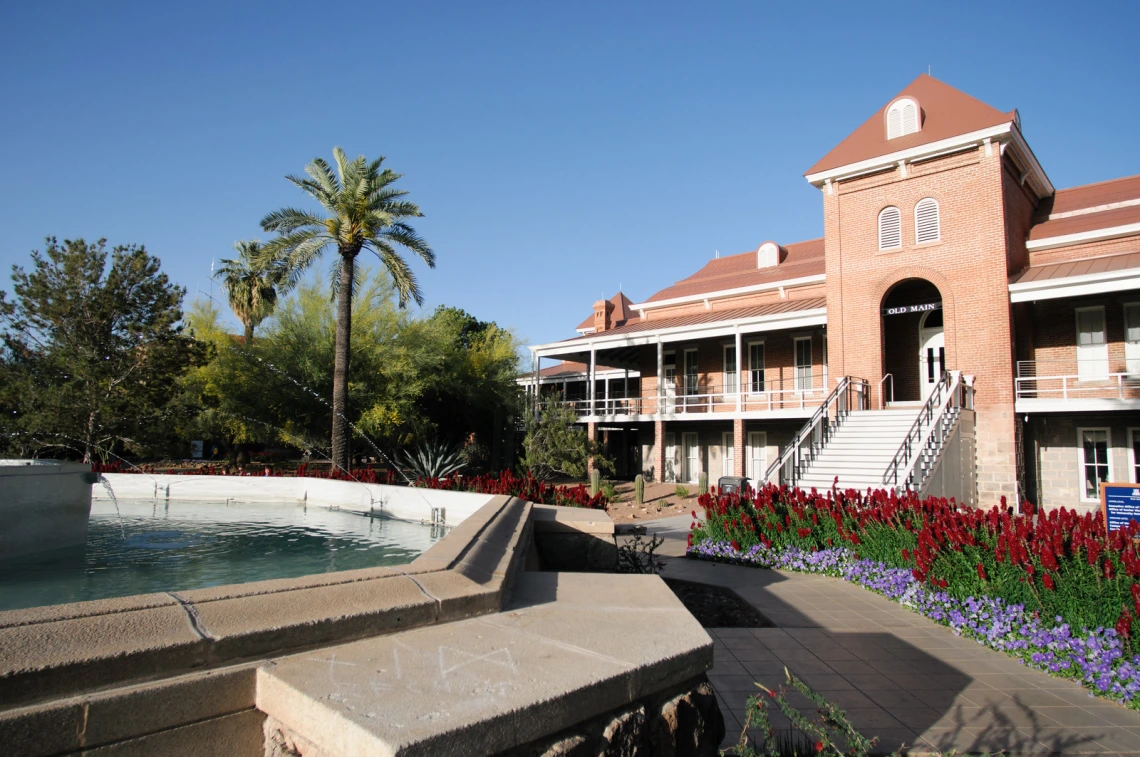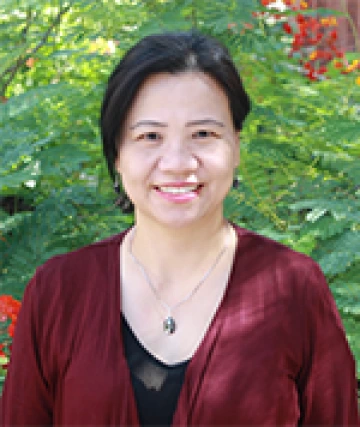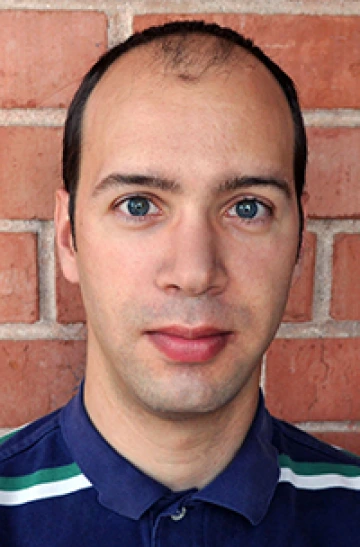Faculty Elected Senior Members of the National Academy of Inventors

Tucson, Ariz. – The National Academy of Inventors (NAI) has named 38 academic inventors to the August 2020 class of NAI Senior Members. Among these are four distinguished University of Arizona faculty: Professor of Optical Sciences Dr. Tom Milster; Professor of Chemistry and Biochemistry Dr. Minying Cai; Assistant Professor of Medical Imaging Dr. Luca Caucci; and Dr. Eugene Gerner, emeritus professor of cell biology and anatomy.
NAI Senior Members are active faculty, scientists and administrators from NAI Member Institutions who have demonstrated remarkable innovation producing technologies that have brought, or aspire to bring, real impact on the welfare of society. They also have growing success in patents, licensing and commercialization.
Nomination for NAI Senior Member by an individual’s supporting institution is a distinct honor and a significant way for the organization to publicly recognize its innovators on a national level.
These Senior Members will continue to foster a spirit of innovation, while educating and mentoring the next generation of inventors.
“Working with inventors like these to protect their discoveries and work to get them out into the public is one of the best parts of our job,” said Doug Hockstad, assistant vice president of Tech Launch Arizona, the university’s commercialization arm. “UArizona is fortunate to have inventors like these four, creating innovations that will change the world and then working with TLA to move them into the public sphere.”
This latest class of NAI Senior Members represents 24 research universities, government, and non-profit research institutes. They are named inventors on over 397 issued U.S. patents.
Dr. Eugene Gerner

Dr. Eugene Gerner
Dr. Gerner(link is external) is a co-founder and Chief Science Officer of UArizona startup Cancer Prevention Pharmaceuticals LLC (CPP) based on his research and discoveries. CPP is a clinical stage company established in 2008 to develop therapies to prevent cancer inpeople with elevated risks for the diseases. In 2013, CPP received funding from the National Cancer Institute for a colon cancer clinical trial during which over 1,300 colon cancer survivors received daily treatment for three years to prevent the occurrence of colorectal cancer or high-risk polyps and compare the effects to a placebo group.
Dr. Gerner is a great advocate of and participant in technology commercialization at the UArizona, having been an inventor on 14 invention disclosures to TLA. 32 U.S. patents filed have listed him as an inventor, and 10 of those have been granted. Six of the technologies he either led or co-invented have been exclusively licensed, and the technologies licensed to CPP are expected to go on and greatly improve the outlook for individuals at high risk for colon cancer.
Gerner’s work has been funded by grants from the National Cancer Institute, including two rounds of funding for a Specialized Program of Research Excellence (SPORE) in Gastrointestinal Cancer.
"I was honored to be nominated for this election by colleagues at The University of Arizona," he said. "It is personally gratifying to be recognized by peers for my contributions. It is especially rewarding to see the results of my research be translated into practical solutions to address societal problems."
Minying Cai, Ph.D.

Minying Cai, Ph.D.
Minying Cai has been with the UArizona Chemistry & Biochemistry department for more than 20 years and has more than 100 publications and numerous patents in the area of novel drug discovery for obesity, diabetes, cancer, pain and neuro-disorder diseases. Dr. Cai received her Ph.D. at the UA in Biochemistry and Molecular Biophysics.
Her research focuses on identifying and developing molecular modulators of melanocortin receptors for the therapeutic treatment of numerous medical disorders associated with the skin, including melanoma, metabolic, and central nervous system disorders.
Melanoma is the deadliest form of skin cancer in the United States. Recent medical breakthroughs have successfully prolonged the median overall survival for malignant melanoma patients. Nevertheless, tumor cells eventually become resistant to these treatments. Cai has developed new compounds and approaches to overcome tumor resistance to chemotherapy.
She has been an inventor on 21 invention disclosures and 35 filed patents. The seven issued U.S. patents bearing her name have all been exclusively licensed. Her inventions have gone on to be the foundations of three startups.
Her work has been recognized by the UArizona through a Galileo Circle Copernicus Award, and she received high honors from the China Ministry of Science & Technology and the China Ministry of Agriculture. Her research has primarily been funded by the National Institutes of Health.
"It is my greatest honor to receive this award," Cai said. "I wish to take this opportunity to thank all the collaborators, including students from around the world, who I have been working with in the previous 21 years. This will inspire me to continue developing new technologies and drugs to combat the many challenges in health."
Thomas Milster, Ph.D.

Tom Milster. Photo: James C. Wyant College of Optical Sciences
Tom Milster is a Professor in the UArizona James C. Wyant College of Optical Sciences. During his career he has also been an Optical Engineer with Lawrence Livermore National Laboratory and a Staff Engineer for IBM’s General Products Division.
His research has focused on hyper-NA imaging and near field optics, optical data storage, statistical imaging and the OPTISCAN Simulation Project, a tool for simulating the operation of optical systems.
Most recently, Milster and two co-inventors developed a new Raman spectrometer that can analyze the chemical makeup of samplesand requires minimal training to operate. The technology was licensed to startup Botanisol Analyticsin 2017. The company, in collaboration with other partners, recently won a $1.5 million contract to build the systems for the Air Force Research Laboratory. With additional discretionary funding, Botanisol Analytics anticipates being able to field COVID-19 screeners in the fall of 2020.
He has been an inventor on 47 disclosures and 40 filed patents. With 10 U.S. patents to his name, 6 six of those have been exclusively licensed.
Milster has been recognized by a multitude of organizations, including election as Fellow to the Optical Society and SPIE. His research has been funded by the National Science Foundation, as well as multiple private companies.
"I am honored to be elected as a Senior Member into the National Academy of Inventors," he said. "It is humbling to be included with such outstanding academic inventors."
Luca Caucci, Ph.D.

Luca Caucci, Ph.D.
Luca Caucci received his Ph.D. in Optical Sciences from the UArizona in 2012. He has been an Assistant Research Professor in the Department of Medical Imaging since 2014.
His current research interests are in medical imaging and computing. Applications include task-based assessment of image quality, optimal methods for signal detection and parameter estimation, adaptive systems, photon-processing detector, and fast computational methods on parallel architectures for photon-processing data processing for PET and SPECT imaging.
Caucci is the PI of a National Institutes of Health grant titled “Emission Computed Tomography and Parallel Computing." He has been granted six U.S. Patents, one of them currently being licensed.
In 2011, he was named Outstanding Graduate Student at the College of Optical Sciences.
“Becoming a Senior Member of the National Academy of Inventors represents a huge achievement for me, both academically and personally,” he said. “This would not have been possible without the help I received from my co-inventors and the support from the University of Arizona.”
About NA Senior Members
“NAI Member Institutions support some of the most elite innovators on the horizon. With the NAI Senior Member award distinction, we are recognizing innovators who are rising stars in their fields and the innovative ecosystems that support their work,” said Paul R. Sanberg, NAI President. “This new class is joining a prolific group of academic visionaries already defining tomorrow.”
Following a nomination for NAI Senior Member, individuals undergo a rigorous selection process by the NAI Advisory Committee, which is composed of elected NAI members and other professionals considered pioneers in their respective field.
Senior Members are elected biannually, and nominations are accepted on a rolling basis. Nominations are currently being accepted for the next Senior Member class.
The University of Arizona now has a total of nine Senior Members and nine Fellows. A full list of NAI Senior Members and Fellows is available on the NAI website(link is external).
###
About the National Academy of Inventors
The National Academy of Inventors is a member organization comprising U.S. and international universities, and governmental and non-profit research institutes, with over 4,000 individual inventor members and Fellows spanning more than 250 institutions worldwide. It was founded in 2010 to recognize and encourage inventors with patents issued from the U.S. Patent and Trademark Office, enhance the visibility of academic technology and innovation, encourage the disclosure of intellectual property, educate and mentor innovative students, and translate the inventions of its members to benefit society. The NAI publishes the multidisciplinary journal, Technology and Innovation. www.academyofinventors.org(link is external)

